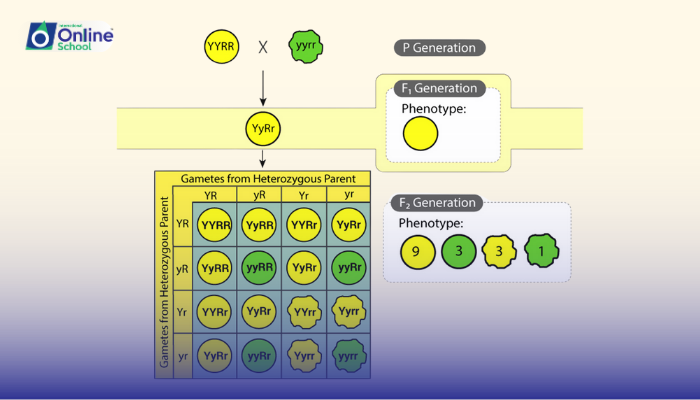
Learning Outcomes:
i. Define the Law of Independent Assortment as stated by Gregor Mendel.
ii. Explain the concept of chromosomal segregation and its role in independent assortment.
iii. Apply the Law of Independent Assortment to predict the possible inheritance patterns of two distinct traits in a simple genetic cross.
iv. Appreciate the significance of independent assortment in generating genetic diversity within populations.
Introduction:
Imagine a magician's hat, brimming with colorful scarves. Each scarf represents a different trait, like seed shape and seed color in a pea plant. Now, picture the magician pulling out scarves one by one, each independent of the other. This, in essence, is the Law of Independent Assortment, a fundamental principle of genetics that reveals how genes located on different chromosomes dance to their own tunes during gamete formation, creating a kaleidoscope of possibilities in offspring.
i. The Chromosomal Stage: Setting the Scene for Independence
Our DNA, the blueprint of life, is housed within thread-like structures called chromosomes. During the formation of gametes (eggs and sperm), these chromosomes undergo a fascinating process called meiosis. Imagine the magician sorting the scarves into separate boxes, one box for each chromosome. This separation, known as chromosomal segregation, ensures that each gamete receives only one copy of each chromosome from each parent.
ii. The Independent Act: Genes Do Their Own Thing
Now, here's the magic – the Law of Independent Assortment. Unlike the scarves in the same box, which are limited in their combinations, genes located on different chromosomes don't influence each other's inheritance. Each gene, like a solo act in the magician's show, independently determines which of its two versions (alleles) ends up in a gamete. This independence allows for a vast array of possible combinations, just like the magician pulling out any combination of colored scarves.
iii. Putting the Theory into Practice: A Seed-y Example
Let's take the example of pea plants. Imagine two genes, one for seed shape (round or wrinkled) and another for seed color (green or yellow). Each parent carries two different alleles for each gene, creating four possible combinations for each gamete. Applying the Law of Independent Assortment, we can predict the possible offspring genotypes and phenotypes (physical expression of the trait) in a cross between these parents. This reveals a fascinating array of possibilities, including offspring with round yellow seeds, wrinkled green seeds, and many combinations in between, all thanks to the independent dance of genes on different chromosomes.
iv. The Symphony of Diversity: A Chorus of Genes
The Law of Independent Assortment is not just about pea plants. It plays a crucial role in generating genetic diversity within all living things. Imagine a large orchestra, where each instrument represents a different gene on a different chromosome. The Law of Independent Assortment allows these instruments to play their melodies independently, creating a harmonious symphony of diverse traits within populations. This diversity is essential for adaptation, survival, and the continued evolution of life on Earth.
The Law of Independent Assortment, like the magician's colorful scarves, reveals the beauty and complexity of inheritance. It reminds us that our traits are not predetermined but rather a product of a dynamic interplay between genes and chance, creating a unique tapestry of life woven from the threads of independence. By understanding this principle, we gain a deeper appreciation for the intricate dance of life, the endless possibilities that lie within our genetic blueprint, and the incredible diversity that enriches our world.